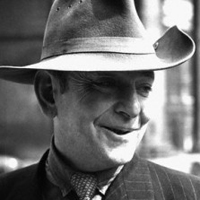The Zulu Girl by Roy Campbell: Summary
In the first stanza, the speaker describes the setting in which the Zulu girl and her group are working: "When in the sun the red hot acres smoulder...a girl flings down her hoe, and from her shoulder unslings her child." With the details of the first and the second lines, we are soon introduced to the individual member, a girl who has become a mother and is carrying the child on her back while she is working with the group.

Roy Campbell (1901-1957)
In the second stanza, we see the girl –mother separated from the group as she goes under a tree to feed her child. The poet soon begins describing the act of breast-feeding in ‘violent’ terms, suggesting the repressed energy of the tribe. The very caressing of the child by the mother is described in the words of a tiger moving about slowly (prowl) and the energy of the electric. In the third stanza, the poet draws our attention to the child grunting and sucking as he is also about to fall asleep. He is seen as a socket into which a plug is thrust and the energy is passed on. But the flow of the mother’s milk is also seen as the flow of a river. “Through his frail nerves her own deep languors ripple / Like a broad river sighing through its reeds”. The river of the mother’s milk is seen as something to put out the fire in the child’s body! And yet it is not able to quench the “unsmotherable heat” or thirst; for the child belongs to the tribe whose fierceness is ‘curbed’ for generations.
But the tribe is one that has retained its dignity even though it is beaten. As the dazed child (for he is drunk) looks at his mother, he sees her like a mountain, on the base of which there is the Negro village. She becomes a landscape, geography, the African land. But the image is further developed when the poet (from the viewpoint of the almost sleeping child) describes the mother as a ‘cloud’ that is pregnant with a coming spring-rain, which will bring about a revolutionary change in the barren land of the tribes. The poem thus ends with a clear hint of a coming revolution. It simply proves that a poet does not need a special subject to write an extra-ordinary poem.
Cite this Page!
Sharma, Kedar N. "The Zulu Girl by Roy Campbell: Summary." BachelorandMaster, 2 Dec. 2013, bachelorandmaster.com/britishandamericanpoetry/the-zulu-girl-summary.html.
Related Topics
 |
bachelorandmaster.com |